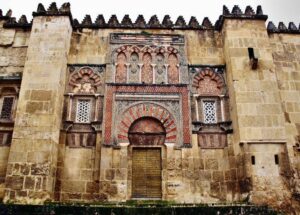History of the Reinos de Taifas period
The Umayyad Caliphate of Córdoba was abolished in 1031, dividing the territory into small kingdoms called “Taifas.” Taifa translates from Arabic as “camp” or “faction.”
The sovereigns of these kingdoms were searching for power and prestige, competing with one another militarily and promoting their local products, culture, and art. The Reinos de Taifas period was one of the most splendid and fruitful periods in the history of the Iberian Peninsula in terms of culture, literature, and art.

First Reinos de Taifas period
The “Reinos de Taifas” or “Taifas” were the small autonomous regions shaping the Iberian Peninsula’s territory. The first period of Taifas started after the abolition of the Umayyad Caliphate in the tenth century. The Taifas were independent of each other, with all the infrastructure needed to protect themselves, like proper kingdoms.
Art
That was the era of the great Arabian poet Ibn Zaydun and his beloved Wallada. The couple died on the same day that the Almoravid Muslims entered the city of Cordoba in 1091. That year, many of the Taifas (Cordoba, Seville, and Jaén, among others) surrendered to these Muslims coming from the North of Africa.
War
During this unstable period, the Taifas were battling each other. The kings of the Taifas were hiring mercenaries to fight against other Muslim rulers, like the Almoravids from Northern Africa. They were also at war with the Catholic Kings in the peninsula’s North. One of the mercenaries who fought in these battles was the famous Spanish nobleman and military leader “El Cid”, admired for his military prowess.
The Muslim fragmentation in so many kingdoms and their internal battles led to the submission of these “taifas” to the Catholic kings. They demanded payment of an annual tribute to the conquered Taifas.
Second Reinos de Taifas period
After the fall of the Almoravid Empire (1085-1144), there was a second period of taifas (until 1172). Al-Andalus was a territory ruled by Muslims in the Iberian Peninsula. It was politically fragmented again, similar to when the abolition of the Caliphate took place.
Third Reinos de Taifas period
The Almohads were another tribe arriving from the North of Africa. They aimed to reconquer the Iberian Peninsula to regain the Muslim unity. Almohads ruled until The Battle of Las Navas de Tolosa in 1212, where the Christians defeated the Muslims. For the third time, there was a division in the Iberian Peninsula into the “Reinos de Taifas”. However, the ever-changing political leadership never impeded the dominance of the “Reinos de Taifas” concerning the economy, art and culture.
Reinos de Taifas and olive oil
King Almutamid of Seville (1069-1090) found a way to pay tributes to the Catholic Kings to guarantee a peaceful cohabitation. Some Muslim Taifas kings sent money or women to pay these tributes. Almutamid decided to offer one of his most precious goods: the olive oil from the provinces of Cordoba and Jaen. Many considered his olive oil to be liquid gold. Thanks to him, the trading developed with the other Christian kingdoms and taifas, including the taifa of Zaragoza, which was very important by then, with the famous “El Cid” fighting for them from 1081 to 1086.
Buying monovarietal olive oil as a gift
If you think olive oil is a perfect gift for your loved ones and you are looking for one, feel free to pop by our online shop. We specialise in monovarietal extra virgin olive oil.
Author
Blanca Navarro Gavilán – PhD, BA History at the University of Cordoba
Cristina Ayuso translated this text into English – BA. Translation & Interpreting at the University of Granada
Medina Azahara
Spain’s caliphate city of Medina Azahara is a heritage of the Ummayad caliphate. On Sunday the 1st of July 2018 was added to the United Nations Educational, Scientific and Cultural Organization (UNESCO) List of World Heritage.
Cordoba becomes the first city with four World Heritage declarations. Here you can see the video used to opt for this award.
